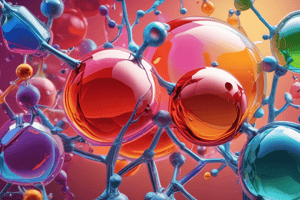Podcast
Questions and Answers
What distinguishes primary alcohols from tertiary alcohols?
What distinguishes primary alcohols from tertiary alcohols?
The number of alkyl groups attached to the carbon bearing the hydroxyl group
How are phenols different from alcohols?
How are phenols different from alcohols?
Phenols are aromatic alcohols with the hydroxyl group connected to a benzene ring.
What type of compounds are ethers?
What type of compounds are ethers?
Ethers are organic compounds containing an oxygen atom bonded to two alkyl or aryl groups.
What type of reactions can alcohols participate in?
What type of reactions can alcohols participate in?
What characteristic property of phenols leads to their stability and reactivity?
What characteristic property of phenols leads to their stability and reactivity?
What are the two classifications of ethers based on the groups attached to the oxygen atom?
What are the two classifications of ethers based on the groups attached to the oxygen atom?
What are the characteristics of ethers that make them useful as solvents in organic syntheses?
What are the characteristics of ethers that make them useful as solvents in organic syntheses?
Define nucleophilic substitution reactions in organic chemistry.
Define nucleophilic substitution reactions in organic chemistry.
Name two types of nucleophilic substitution reactions and briefly explain their differences.
Name two types of nucleophilic substitution reactions and briefly explain their differences.
What is the key characteristic of electrophilic aromatic substitution reactions?
What is the key characteristic of electrophilic aromatic substitution reactions?
Flashcards are hidden until you start studying
Study Notes
Organic Chemistry: A Journey through Alcohols, Phenols, Ethers, and Reactions
Organic chemistry, a field that encompasses the study of carbon-containing compounds, is a fascinating and diverse discipline. It's home to a myriad of molecules, including alcohols, phenols, ethers, and the various reactions these entities undergo. Let's dive into each of these subtopics, unraveling their roles and properties that have shaped the landscape of organic chemistry.
Alcohols
Alcohols are organic compounds containing a hydroxyl group (−OH) bonded to an alkyl or aryl group. They're classified according to their carbon count:
- Primary alcohols (1°) have one alkyl group attached to the carbon bearing the hydroxyl group.
- Secondary alcohols (2°) have two alkyl groups attached to the carbon bearing the hydroxyl group.
- Tertiary alcohols (3°) have three alkyl groups attached to the carbon bearing the hydroxyl group.
Alcohols participate in a variety of reactions, including dehydration, oxidation, and reduction.
Phenols
Phenols are aromatic alcohols, meaning that the hydroxyl group is connected to a benzene ring. The presence of the hydroxyl group in a phenol imparts distinct properties that set them apart from alcohols. Phenols can form resonance structures, leading to their characteristic stability and reactivity.
Ethers
Ethers are organic compounds containing an oxygen atom bonded to two alkyl or aryl groups. They're classified as either alkyl ethers or aryl ethers depending on the types of groups attached to the oxygen atom. Ethers are relatively stable and are often used as solvents in organic syntheses because they are neither reducing nor oxidizing agents.
Organic Chemistry Reactions
Nucleophilic Substitution Reactions
Nucleophilic substitution reactions are among the most common reactions in organic chemistry. These reactions involve the replacement of a leaving group (X) by a nucleophile (Nu). Nucleophilic substitution reactions can occur in several ways, such as:
- Substitution nucleophilic bimolecular (SN2)
- Substitution nucleophilic bimolecular with inversion of configuration (SN2i)
- Substitution nucleophilic unimolecular (SN1)
Electrophilic Aromatic Substitution Reactions
Electrophilic aromatic substitution reactions involve the replacement of a hydrogen atom (or other electron-donating groups) with an electrophile. These reactions proceed through a series of steps, known as the electrophilic aromatic substitution mechanism, and are characterized by the conservation of aromaticity.
Oxidation and Reduction Reactions
Oxidation and reduction reactions are fundamental processes in organic chemistry. They involve the loss (oxidation) or gain (reduction) of electrons, leading to changes in the oxidation state of the substrate. Oxidation and reduction reactions are used to synthesize or transform various organic compounds.
Organic Chemistry Nomenclature
Organic chemistry nomenclature refers to the system of naming organic compounds using specific rules and conventions. The International Union of Pure and Applied Chemistry (IUPAC) provides guidelines for naming organic compounds, ensuring consistency and clarity.
In summary, understanding alcohols, phenols, ethers, and the reactions they undergo forms the backbone of organic chemistry. This discipline is a treasure trove of information and techniques that continues to fuel the advancement of science and technology. As you delve deeper into this fascinating field, your appreciation for its complexity and beauty will undoubtedly grow.
Studying That Suits You
Use AI to generate personalized quizzes and flashcards to suit your learning preferences.




